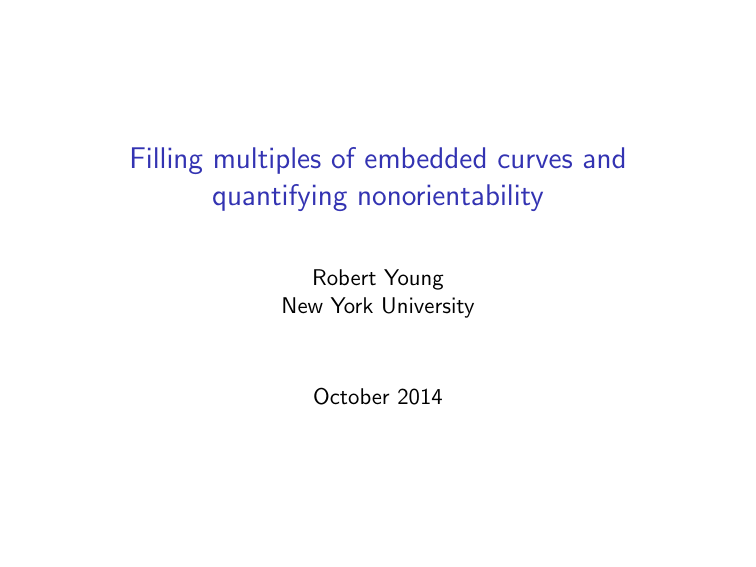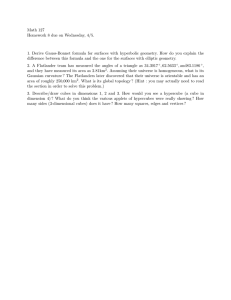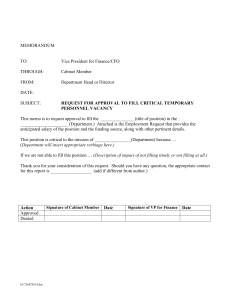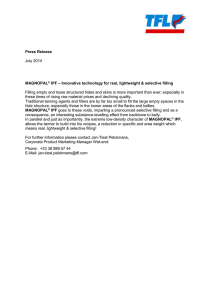Filling multiples of embedded curves and quantifying nonorientability Robert Young New York University
advertisement

Filling multiples of embedded curves and
quantifying nonorientability
Robert Young
New York University
October 2014
Part 1
Filling multiples of embedded curves
If T is an integral 1-cycle (i.e., union of oriented closed curves) in
Rn , let FA(T ) be the minimal area of an integral 2-chain with
boundary T .
Part 1
Filling multiples of embedded curves
If T is an integral 1-cycle (i.e., union of oriented closed curves) in
Rn , let FA(T ) be the minimal area of an integral 2-chain with
boundary T .
How is FA(T ) related to FA(2T )?
FA(T ) and FA(2T )
For all T , FA(2T ) ≤ 2 FA(T ).
FA(T ) and FA(2T )
For all T , FA(2T ) ≤ 2 FA(T ).
I
n = 2: If T is a curve in R2 , then FA(2T ) = 2 FA(T ).
FA(T ) and FA(2T )
For all T , FA(2T ) ≤ 2 FA(T ).
I
n = 2: If T is a curve in R2 , then FA(2T ) = 2 FA(T ).
I
n = 3: If T is a curve in R3 , then FA(2T ) = 2 FA(T ).
(Federer, 1974)
FA(T ) and FA(2T )
For all T , FA(2T ) ≤ 2 FA(T ).
I
n = 2: If T is a curve in R2 , then FA(2T ) = 2 FA(T ).
I
n = 3: If T is a curve in R3 , then FA(2T ) = 2 FA(T ).
(Federer, 1974)
I
n = 4: There is a curve T ∈ R4 such that
FA(2T ) ≤ 1.52 FA(T )
(L. C. Young, 1963)
L. C. Young’s example
Let K be a Klein bottle
L. C. Young’s example
Let K be a Klein bottle and let T be the sum of 2k + 1 loops in
alternating directions.
L. C. Young’s example
I
T can be filled with k
bands and one extra disc D
I
FA(T ) ≈
area K
2
+ area D
L. C. Young’s example
I
T can be filled with k
bands and one extra disc D
I
FA(T ) ≈
area K
2
+ area D
I
2T can be filled with
2k + 1 bands
I
FA(2T ) ≈ area K
L. C. Young’s example
I
T can be filled with k
bands and one extra disc D
I
FA(T ) ≈
area K
2
+ area D
I
2T can be filled with
2k + 1 bands
I
FA(2T ) ≈ area K — less
than 2 FA(T ) by 2 area D!
The main theorem
Q: Is there a c > 0 such that FA(2T ) ≥ c FA(T )?
The main theorem
Q: Is there a c > 0 such that FA(2T ) ≥ c FA(T )?
Theorem (Y.)
Yes! For any d, n, there is a c such that if T is a (d − 1)-cycle in
Rn , then FA(2T ) ≥ c FA(T ).
Dividing by 2: dimension zero
+
-
-
-
+
-
+
+
+
T
-
Dividing by 2: dimension zero
+
-
+
-
-
+
+
+
-
+
T
-
-
-
+
+
+
-
+
A filling of 2T
-
Dividing by 2: dimension zero
+
-
+
-
-
+
-
+
+
-
+
-
-
+
+
-
+
+
A filling of 2T
T
+
-
-
+
+
+
-
+
A filling of T
-
-
Generalizing
+
-
-
-
+
-
+
+
+
+
-
≡
-
-
-
+
-
+
+
+
The filling forms an orientable closed curve.
-
(mod 2)
Generalizing
+
-
-
-
+
-
+
+
+
+
≡
-
-
-
+
-
+
(mod 2)
+
-
+
-
The filling forms an orientable closed curve.
We use an orientation to construct a filling of T .
+
-
-
-
+
-
+
+
+
+
-
+
-
-
-
+
-
+
+
+
+
-
= 2·
-
-
-
+
-
+
+
+
-
The Klein bottle, again
Let T be a cycle and suppose that
∂B = 2T .
B
The Klein bottle, again
Let T be a cycle and suppose that
∂B = 2T .
Then
∂B ≡ 0
(mod 2),
so B is a mod-2 cycle.
B (mod 2)
The Klein bottle, again
Let T be a cycle and suppose that
∂B = 2T .
Then
∂B ≡ 0
(mod 2),
so B is a mod-2 cycle.
If R is an integral cycle such that
B ≡ R (mod 2) (a pseudo-orientation of B)
R
The Klein bottle, again
Let T be a cycle and suppose that
∂B = 2T .
Then
∂B ≡ 0
(mod 2),
so B is a mod-2 cycle.
If R is an integral cycle such that
B ≡ R (mod 2) (a pseudo-orientation of B),
then
B + R ≡ 0 (mod 2)
B +R
2T + 0
∂
=
= T.
2
2
R
The Klein bottle, again
+
= 2·
Nonorientability volume
If A is a mod-2 cycle, define the nonorientability volume of A by
NOV(A) = inf{mass R | R is a pseudo-orientation of A}
Nonorientability volume
If A is a mod-2 cycle, define the nonorientability volume of A by
NOV(A) = inf{mass R | R is a pseudo-orientation of A}
If ∂B = 2T , then
FV(T ) ≤ mass B + NOV(B mod 2)
Nonorientability volume
If A is a mod-2 cycle, define the nonorientability volume of A by
NOV(A) = inf{mass R | R is a pseudo-orientation of A}
If ∂B = 2T , then
FV(T ) ≤ mass B + NOV(B mod 2)
So, to prove the theorem when T is a d-cycle, it suffices to show:
Proposition
If A is a mod-2 (d + 1)-cycle in Rn , then NOV(A) . mass A.
End of Part 1
Part 2
Quantifying nonorientability
We would like to show:
Proposition
If A is a mod-2 cycle in Rn , then NOV(A) . mass A.
Part 2
Quantifying nonorientability
We would like to show:
Proposition
If A is a mod-2 cycle in Rn , then NOV(A) . mass A.
Strategy: Construct a pseudo-orientation of A by viewing A as the
boundary of something orientable.
Codimension 1
If A is a mod-2 (d + 1)-cycle in Rd+2 , it’s the boundary of a
mod-2 (d + 2)-chain:
Codimension 1
If A is a mod-2 (d + 1)-cycle in Rd+2 , it’s the boundary of a
mod-2 (d + 2)-chain:
→
This decomposes A into orientable pieces!
Codimension 1
This explains why FA(2T ) = 2 FA(T ) when T is a closed curve in
R3 – every 2-cycle in R3 is orientable.
Codimension 1
This explains why FA(2T ) = 2 FA(T ) when T is a closed curve in
R3 – every 2-cycle in R3 is orientable.
Even the Klein bottle:
→
First try: decompose A into unit cubes
Let A be a mod-2 cellular d-cycle of mass V
First try: decompose A into unit cubes
Let A be a mod-2 cellular d-cycle of mass V
I
Fill A with a mod-2 chain
First try: decompose A into unit cubes
Let A be a mod-2 cellular d-cycle of mass V
I
Fill A with a mod-2 chain
I
This is a sum of V (d+1)/d cubes, each with side length ∼ 1
First try: decompose A into unit cubes
Let A be a mod-2 cellular d-cycle of mass V
I
Fill A with a mod-2 chain
I
This is a sum of V (d+1)/d cubes, each with side length ∼ 1
I
Orient the cubes at random and sum to get a
pseudo-orientation
First try: decompose A into unit cubes
Let A be a mod-2 cellular d-cycle of mass V
I
Fill A with a mod-2 chain
I
This is a sum of V (d+1)/d cubes, each with side length ∼ 1
I
Orient the cubes at random and sum to get a
pseudo-orientation
I
Total boundary: V (d+1)/d
Second try: bigger cubes
Total boundary: V (d+1)/d
Second try: bigger cubes
Total boundary: V (d+1)/d
Total boundary: ???
Filling through approximations
A = A0
Filling through approximations
A = A0
A1
Filling through approximations
A = A0
A1
A2
Filling through approximations
A = A0
A1
Filling through approximations
A = A0
∼ V squares each with perimeter ∼ 1
A1
Filling through approximations
A = A0
A1
∼ V squares each with perimeter ∼ 1
A1
A2
Filling through approximations
A = A0
A1
∼ V squares each with perimeter ∼ 1
A2
A1
∼ V /2 squares each with perimeter ∼ 2
Estimating nonorientability area
At each scale, we use cubes with total boundary ∼ V . Since there
are ∼ log V scales, we conclude:
Proposition (Guth-Y.)
If A is a cellular mod-2 d-cycle with volume V , then it has a
pseudo-orientation R such that mass R . V log V .
Regularity and rectifiability
Definition
A set E ⊂ Rn is Ahlfors d-regular if for any x ∈ E and any
0 < r < diam E ,
Hd (E ∩ B(x, r )) ∼ r d .
Definition
A set E ⊂ Rn is d-rectifiable if it can be covered by countably
many Lipschitz images of Rd .
Uniform rectifiability
Definition (David-Semmes)
A set E ⊂ Rn is uniformly d-rectifiable if it is d-regular and there
is a c such that for all x ∈ E and 0 < r < diam E , there is a
c-Lipschitz map Bd (0, r ) → Rn which covers a 1/c-fraction of
B(x, r ) ∩ E .
Sketch of proof
Proposition
Every mod-2 cellular d-cycle A can be written as a sum
X
A=
Ai
i
of mod-2 cellular d-cycles with uniformly rectifiable support such
that
X
mass Ai ≤ C mass A.
Sketch of proof
Proposition
Every mod-2 cellular d-cycle A can be written as a sum
X
A=
Ai
i
of mod-2 cellular d-cycles with uniformly rectifiable support such
that
X
mass Ai ≤ C mass A.
Proposition
Any mod-2 cellular d-cycle A with uniformly rectifiable support has
a pseudo-orientation R with
mass R ≤ C mass A.
Open questions
I
More generally,
FV(T ) ≥ ck
Can the ck be chosen uniformly?
FV(kT )
.
k
Open questions
I
More generally,
FV(T ) ≥ ck
FV(kT )
.
k
Can the ck be chosen uniformly?
I
What’s the relationship between integral filling volume and
real filling volume? Real flat norms and integral flat norms?
Open questions
I
More generally,
FV(T ) ≥ ck
FV(kT )
.
k
Can the ck be chosen uniformly?
I
What’s the relationship between integral filling volume and
real filling volume? Real flat norms and integral flat norms?
I
What does this tell us about surfaces embedded in Euclidean
space?





![Problem Set 5 [Word]](http://s3.studylib.net/store/data/006809492_1-3a6588f3420f43040631c60a37bd1b28-300x300.png)